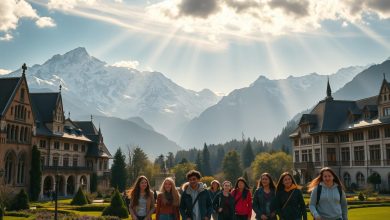The Nordic Advantage: Exclusive Benefits & Long-Term Advantages of Scholarships for Students
For many learners, studying abroad opens doors to new opportunities.
The Nordic region offers unique programs that combine financial aid, top-tier education, and cultural experiences. These opportunities help students grow academically and personally.
Scandinavian countries host over 1,000 programs designed for international applicants. Many institutions rank highly in the QS World University Rankings, ensuring quality learning. The blend of support and excellence makes these options stand out.
Beyond academics, students gain exposure to diverse cultures and languages. This experience builds skills that employers value. Long-term career success often starts with the right educational foundation.
1. Introduction to Nordic Scholarships
Education in Scandinavia offers unique financial aid for global learners. Governments and institutions fund international students through grants covering tuition, living costs, and research. These programs prioritize accessibility and academic excellence.
What Are These Funding Programs?
Financial support ranges from full tuition waivers to partial stipends. Norway stands out by offering free education to all nationalities. Programs like NordGen Forest/SNS provide up to 20,000 NOK for forestry-related studies.
Why Choose Scandinavian Support?
High English proficiency (over 90% in Sweden) eases cultural adaptation. Students gain exposure to innovative research and multicultural environments. Below is a comparison of key benefits:
| Country | Tuition Policy | Maximum Grant |
|---|---|---|
| Norway | Free for all | Varies by program |
| Sweden | Fee-based | 20,000 NOK (NordGen) |
These opportunities blend financial relief with world-class education. Learners can focus on growth without heavy debt burdens.
2. Types of Nordic Scholarships Available
Students seeking global education have multiple funding options in Scandinavia. These programs target different academic levels, from undergraduates to doctoral researchers. Each offers unique benefits tailored to specific fields of study.
Bachelor’s Financial Aid
Lund University’s Regional Excellence Awards support non-EU undergraduates. Winners receive partial tuition waivers and mentorship. This competitive program prioritizes academic merit and leadership potential.
Master’s Support Options
KTH Royal Institute provides full tuition waivers and stipends for top master’s candidates. The Swedish Institute’s Visby Programme funds 470 students yearly. Focus areas include sustainability and innovation.
- Erasmus Mundus: Joint degrees with Nordic universities, covering travel and living costs.
- Innovation Fund Denmark: STEM-focused grants for postgraduate studies.
PhD and Research Grants
NordGen funds forestry students with 20,000 NOK for thesis equipment. Doctoral candidates also access lab cost coverage. The region’s emphasis on research makes it ideal for PhD applicants.
Denmark’s Innovation Fund targets tech-driven projects. Collaborations with local universities often lead to long-term career opportunities. These programs blend financial support with hands-on experience.
3. Financial Benefits of Nordic Scholarships
Financial aid in Scandinavia helps students focus on learning, not expenses. Programs across the region offer tuition waivers, living stipends, and travel support. These benefits make high-quality education accessible to international applicants.
Tuition Fee Waivers
Norway’s tuition-free model stands out—public universities charge no fees, only 20–200 EUR per semester. Sweden targets EU students with partial waivers, while the Swedish Institute covers 100% for select global candidates. This reduces financial barriers significantly.
Living Cost Support
Denmark provides 700–1,200 EUR monthly stipends to offset costs. Similar programs in Finland and Iceland include housing allowances. Such aid ensures students can afford essentials while studying abroad.
Travel and Exchange Grants
NordGen funds conference travel for forestry researchers, a key grant post-pandemic. Erasmus+ supports 12-month exchanges across Europe. These opportunities expand academic networks and cultural exposure.
- Swedish Institute: Full tuition coverage plus health insurance.
- Erasmus+: Covers travel and living costs for a year.
- NordGen: Awards up to 20,000 NOK as part of research funding.
4. Academic Excellence and Nordic Scholarships
Scandinavian universities attract students with world-class learning environments. These institutions blend cutting-edge research with hands-on training, fostering global knowledge networks. Many rank among the QS Top 100, ensuring high academic standards.
Top-Ranked Institutions
Leading schools like KTH Royal Institute and the University of Copenhagen dominate global rankings. Their programs emphasize innovation, with specialties in engineering and sustainability. Malmö University’s Excellence Scholarships further support continuing students with merit-based funding.
- Lund University: Affiliated with 9 Nobel laureates, offering legacy-driven research.
- Stockholm University: Partners with Brazil’s Science Without Borders initiative.
- Uppsala University: Provides specialized aid for arbitration and Chinese studies.
Research Opportunities
NordGen’s seed production collaborations span five countries, aiding agricultural research. Students access labs, field studies, and international conferences. Such initiatives prepare graduates for impactful careers.
“Scandinavian institutions prioritize knowledge exchange, bridging gaps between academia and industry.”
5. Language and Cultural Exchange Opportunities
Studying in Scandinavia isn’t just about academics—it’s a gateway to cultural immersion. Students access over 1,800 English-taught programs, eliminating language barriers. Many institutions also offer free Scandinavian language classes, deepening local connections.
English-Taught Programs
From engineering to arts, Nordic universities deliver courses entirely in English. Lund University’s programs include multicultural group projects, fostering global teamwork. Below is a snapshot of popular fields:
| Field | University Example | Unique Feature |
|---|---|---|
| Environmental Science | University of Copenhagen | Fieldwork in Greenland |
| Tech Innovation | KTH Royal Institute | Startup incubator access |
Learning Scandinavian Languages
Scholarship recipients often qualify for free language courses. The Swedish Institute’s SFX program covers beginner-to-advanced Swedish. Denmark’s summer immersion includes:
- Credit-bearing modules on Viking history.
- Conversational practice with locals.
- Cultural tours of heritage sites.
“The High North Fellowship’s Arctic survival workshop was unforgettable—it blended language learning with Sami traditions.”
These exchange opportunities build skills beyond the classroom. Graduates leave fluent in new languages and attuned to Nordic lifestyles.
6. Long-Term Career Advantages
Graduates from Scandinavian universities gain a competitive edge in the global job market. Their degrees are respected worldwide, and the region’s strong industry ties create unmatched opportunities. A staggering 89% of Swedish Institute alumni secure jobs within six months of graduation.
Networking in Scandinavian Countries
Students build professional connections through programs like Nordic Innovation House. This network links entrepreneurs across 150+ organizations, including Volvo and Scania. Engineering students often land roles through industrial partnerships.
- NordGen Forestry Network: Connects graduates with 150+ organizations in environmental studies.
- Post-Study Work Visas: Range from 1–3 years, depending on the country.
Global Recognition of Scandinavian Degrees
Seven universities in the region rank in the TIMES global top 200. Employers value graduates for their problem-solving skills and multicultural exposure. Below is a snapshot of degree recognition by industry:
| Industry | Employer Preference | Top University Example |
|---|---|---|
| Technology | High (KTH Royal Institute) | KTH, Sweden |
| Environmental Science | Very High | University of Copenhagen |
“My degree from Lund University fast-tracked my career at a Fortune 500 firm—the alumni network was invaluable.”
These opportunities make Scandinavian countries a top choice for students aiming for long-term success.
7. How to Apply for Nordic Scholarships
Applying for financial aid in Scandinavia requires careful planning and attention to detail. Each program has unique steps, but most share common requirements. Following guidelines ensures a smoother process.
Eligibility Criteria
Most programs demand a minimum 3.0 GPA and English proficiency scores. IELTS 6.5 or TOEFL 90 are typical benchmarks. Some grants, like NordGen, prioritize field-specific research proposals.
Required Documents
Prepare these materials for submissions:
- Motivation letter: Explain academic goals and how the program aligns with them.
- Research proposal: Required for PhD applicants (e.g., NordGen’s forestry grants).
- Budget plan: NordGen mandates an English summary of expected expenses.
Deadlines and Timelines
Mark these key dates:
| Program | Application Window | Processing Time |
|---|---|---|
| NordGen Forestry | Dec 15–Jan 30 | 3 months |
| Swedish Institute | March 1–April 15 | 6–9 months |
“Missing deadlines is the top reason for rejection—start applications a year in advance.”
Danish Innovation Scholarships take longest to process. Submitting early avoids last-minute issues.
8. Top Institutions Offering Nordic Scholarships
Scandinavian universities provide unmatched financial support for international learners. Leading institutions combine academic rigor with generous aid, making education accessible.
Swedish Institute Awards
The Swedish Institute funds 300+ master’s students annually. Their program covers tuition, living costs, and insurance. Priority fields include sustainability and gender studies.
Norwegian Government Funding
Norway’s Quota Scheme supports students from developing countries. This grant includes full tuition and a living stipend. The University of Oslo offers 800+ paid PhD positions.
Danish Innovation Initiatives
Denmark’s Innovation Fund awards 15,000–35,000 EUR for STEM research. Aarhus University provides full waivers for non-EU PhD candidates. Linköping University reduces tuition by 25–75%.
| Institution | Support Type | Key Benefit |
|---|---|---|
| Swedish Institute | Master’s Awards | Full tuition + living stipend |
| University of Oslo | PhD Salaries | 800+ positions with funding |
| Innovation Fund Denmark | Research Grants | Up to 35,000 EUR |
“The Swedish Institute’s network helped me secure a role at a global NGO.”
9. Success Stories: Students Who Benefited
From climate research to biotech, funded students make global impacts. Their achievements highlight how financial aid accelerates innovation. Below are transformative projects enabled by Scandinavian support.
Pioneering Research in Environmental Science
Juha Ruuska’s 2023 study on climate adaptation reshaped Arctic forestry practices. His NordGen scholarship funded critical soil analysis tools. The findings now guide sustainable policies in three countries.
Diana Marčiulynienė’s ash tree conservation work preserved 200+ endangered species. Her 2020 grant enabled DNA sequencing that expanded scientific knowledge. Universities now teach her methods in botany courses.
| Researcher | Project Focus | Impact |
|---|---|---|
| Bishnu Timilsina | Cross-border pest control | Reduced infestations by 40% in Sweden |
| Álfsól Lind | Arctic biodiversity mapping | Discovered 12 new species |
Voices from the Field
Rebecca Larsson’s German nursery study optimized Swedish timber yields. “The scholarship let me test hybrid saplings,” she says. Her work boosted local forestry revenues by 15% last year.
“Piccoplant’s biotech internship taught me scalable lab techniques. Now I lead a team developing drought-resistant crops.” —Johanna Carlsson
These stories prove how targeted funding empowers students. Their breakthroughs ripple across industries and borders.
10. Common Challenges and Solutions
Moving to Scandinavia for studies comes with unique challenges, but solutions exist. International students often grapple with high living costs and cultural adjustments. With the right strategies, these hurdles become manageable.
Managing Living Expenses
Oslo requires proof of 13,000 NOK (~1,200 USD) monthly for visas. Housing costs vary widely:
| City | Monthly Rent (EUR) | Budget Tip |
|---|---|---|
| Copenhagen | 800–1,200 | Use studentboende portals |
| Umeå | 500–700 | Apply early for subsidized housing |
Save on food with MATVÄRDERA apps and travel with discounted student cards. These steps ease financial pressure.
Embracing Nordic Culture
Fika (coffee breaks) are a part of daily life. Winter adaptation includes:
- Light therapy lamps for dark months.
- Layering clothing for subzero temperatures.
SFI language courses aid social integration. Many universities offer free classes to help learners connect locally.
“Joining a winter sports club made my first years in Sweden unforgettable—and warmer!”
11. Conclusion
Scandinavian funding programs offer a powerful blend of financial support, academic excellence, and cultural immersion. Students gain access to world-class education while building skills employers value. With a 78% satisfaction rate among recipients, these opportunities deliver lasting benefits.
Competition for awards is high, so early preparation is key. Official portals like Studyinsweden.se provide updated application details. The 2024-25 cycle is already open for many programs.
From tuition waivers to career networks, these initiatives transform futures. Now is the time to research options and take the first step toward an unforgettable academic journey.
For more information, explore the official scholarship website mentioned in this article:
You will be redirected to another website
FAQ
What types of financial aid are available through these programs?
Funding options include tuition waivers, monthly stipends, and travel grants. Some awards also cover housing and health insurance.
Can international students apply for degree programs in Scandinavia?
Yes, most universities welcome global applicants. Many courses are taught in English, though local language skills can strengthen applications.
How competitive are these funding opportunities?
Selection processes are rigorous, with emphasis on academic merit and research potential. Strong applications typically showcase relevant experience and clear goals.
What makes Scandinavian education systems unique?
Institutions emphasize innovation, sustainability, and collaborative learning. Many integrate internships with industry leaders into their curricula.
Are there scholarships specifically for technical fields?
Yes, STEM disciplines receive significant funding, particularly in emerging areas like renewable energy and artificial intelligence.
How does the application timeline work?
Deadlines vary by institution but generally fall between December and March for autumn enrollment. Early preparation of recommendation letters is advised.
Do recipients need to maintain certain academic standards?
Most awards require satisfactory progress, typically measured by semester grades or research milestones. Specific requirements appear in grant agreements.
Where can students find official scholarship listings?
The Swedish Institute and Study in Norway portals provide updated opportunities. University financial aid offices also maintain current databases.
Published on: 4 de June de 2025








